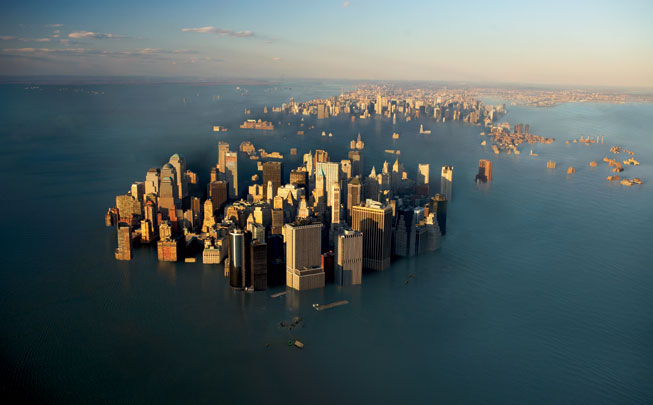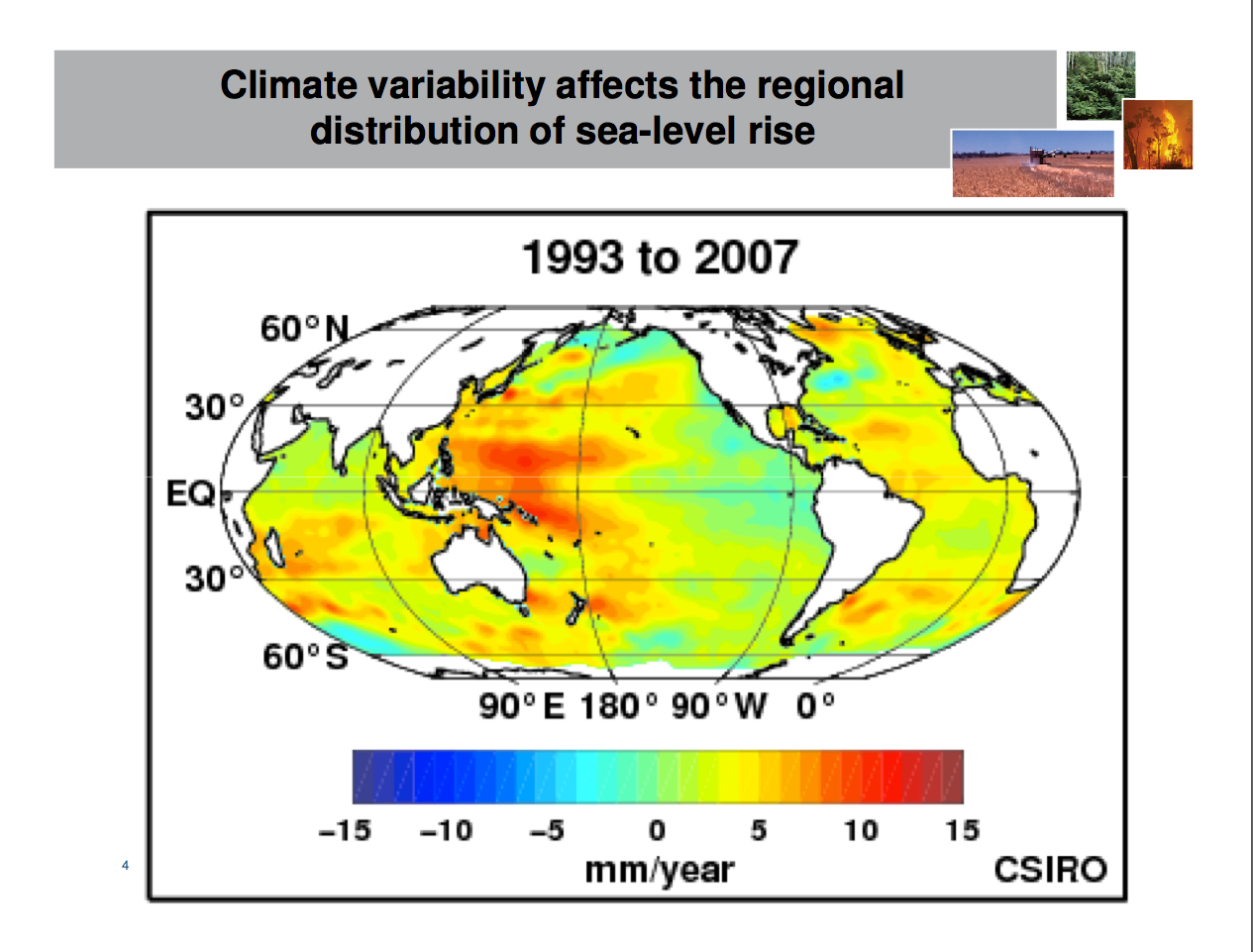Cutting Specific Pollutants Would Slow Sea Level Rise

With coastal areas bracing for rising sea levels, new research indicates that cutting emissions of certain pollutants can greatly slow down sea level rise this century.
The research team found that reductions in four pollutants that cycle comparatively quickly through the atmosphere could temporarily forestall the rate of sea level rise by roughly 25 to 50 percent.
“To avoid potentially dangerous sea level rise, we could cut emissions of short-lived pollutants even if we cannot immediately cut carbon dioxide emissions,” says Aixue Hu of the National Center for Atmospheric Research (NCAR), the first author of the study. “This new research shows that society can significantly reduce the threat to coastal cities if it moves quickly on a handful of pollutants.”
The study, a collaboration of the Scripps Institution for Oceanography, NCAR, and Climate Central, is being published this week in the journal Nature Climate Change. It was funded by the National Science Foundation and the Department of Energy.
“It is still not too late, by stabilizing carbon dioxide concentrations in the atmosphere and reducing emissions of shorter-lived pollutants, to lower the rate of warming and reduce sea level rise,” says Veerabhadran Ramanathan of Scripps, who led the study. “The large role of the shorter-lived pollutants is encouraging since technologies are available to drastically cut their emissions.”
-----Protecting the
coasts-----

The potential impact of rising oceans on populated areas is one of the most concerning effects of climate change. Many of the world’s major cities, such as New York, Miami, Amsterdam, Mumbai, and Tokyo, are located in low-lying areas by the water.
As glaciers and ice sheets melt and warming oceans expand, sea levels have been rising by an average of about 3 millimeters annually in recent years (just more than one-tenth of an inch). If temperatures continue to warm, sea levels are projected to rise between 18 and 59 centimeters (7 to 23 inches) this century, according to a 2007 assessment by the Intergovernmental Panel on Climate Change. Some scientists, however, feel those estimates are too conservative.
Such an increase could submerge densely populated coastal communities, especially when storm surges hit.
Despite the risks, policy makers have been unable to agree on procedures for reducing emissions of carbon dioxide. With this in mind, the research team focused on emissions of four other heat-trapping pollutants: methane, tropospheric ozone, hydrofluorocarbons, and black carbon. These gases and particles last anywhere from a week to a decade in the atmosphere, and they can influence climate more quickly than carbon dioxide, which persists in the atmosphere for centuries.
Previous research by Ramanathan and Yangyang Xu of Scripps, a co-author of the new paper, has shown that a sharp reduction in emissions of these shorter-lived pollutants beginning in 2015 could offset warming temperatures by up to 50 percent by 2050.
Applying those emission reductions to sea level rise, the new research found that the cuts could dramatically slow rising sea levels. Their results showed that total sea level rise would be reduced by an estimated 22 to 42 percent by 2100, depending on the extent to which emissions were reduced.
However, the new study also found that delaying emissions cuts until 2040 would reduce the beneficial impact on year-2100 sea level rise by about a third.
If society were able to substantially reduce both emissions of carbon dioxide as well as the four other pollutants, total sea level rise would be lessened by at least 30 percent by 2100, the researchers concluded.
The researchers used mostly percentage changes for sea level rise, rather than actual estimates in centimeters, because of uncertainties over future temperature increases and their impacts on rising sea levels.
“We still have some control over the amount of sea level rise that we are facing,” Hu says.
Another co-author, Claudia Tebaldi of Climate Central, adds:
"Without diminishing the importance of reducing carbon dioxide emissions in the long term, this study shows that more immediate gains from shorter-lived pollutants are substantial. Cutting emissions of those gases could give coastal communities more time to prepare for rising sea levels. As we have seen recently, storm surges in very highly populated regions of the East Coast show the importance of both making such preparations and cutting greenhouse gases."
To conduct the study, Hu and his colleagues turned to the NCAR-based Community Climate System Model, as well as a second computer model that simulates climate, carbon, and geochemistry. They also drew on estimates of future emissions of heat-trapping gases under various social and economic scenarios and on computer models of melting ice and sea level rise.
The study assumes that society could reduce emissions of the four gases and particles by 30 to 60 percent over the next several decades. That is the steepest reduction believed achievable by economists who have studied the issue at Austria’s International Institute for Applied Systems Analysis, one of the world’s leading research centers into the impact of economic activity on climate change.
“It must be remembered that carbon dioxide is still the most important factor in sea level rise over the long term,” says NCAR scientist Warren Washington, a co-author. “But we can make a real difference in the next several decades by reducing other emissions.”
The University Corporation for Atmospheric Research manages the National Center for Atmospheric Research under sponsorship by the National Science Foundation. Any opinions, findings and conclusions, or recommendations expressed in this publication are those of the author(s) and do not necessarily reflect the views of the National Science Foundation.
About the article
Title: Mitigation of short-lived climate pollutants slows sea-level rise
Authors: Aixue Hu, Yangyang Xu, Claudia Tebaldi, Warren M. Washington, and Veerabhadran Ramanathan (corresponding author)
Publication: Nature Climate Change
On the Web
NCAR/UCAR news releases, images, and more: www.ucar.edu/atmosnews
From Newswise @ http://www.newswise.com/articles/view/601542/?sc=swhn
Sea Surface Temperatures in the Northeast Continental
Shelf Reach Highest Level in 150 Years
By Sam
Lehman
Sea surface temperatures in the Northeast Continental Shelf reach highest level in 150 years (Photo : Reuters)
According to the NOAA's Northeast Fisheries Science Center (NEFSC), the sea surface temperatures (SSTs) in the Northeast Shelf Large Marine Ecosystem have drastically increased to the highest level in the last 150 years in 2012.
With rising temperatures, melting ice caps in the Arctic and record-setting melting rates of ice in the Antarctic Peninsula, NOAA's NEFSC has an addition to the list: the rising temperature at the sea surface of the Northeast Continental Shelf reached the highest level in more than a century, last year. According to the report, the sea surface temperature in the Northeast Shelf Ecosystem reached a record-setting 14 degree Celsius in 2012, which is the highest since 1951.
The measurements of the sea surface temperatures were done via both contemporary satellite remote-sensing data and ship board measurements dated since 1854. The data shows that the temperature has increased more than one degree Celsius only five times, and the SST in 2012 saw the highest increase.
Recently, a tendency of above-average temperatures have been observed during summer and spring seasons, and these high sea surface temperatures are the latest additions to this observation. It is also part of a pattern of elevated temperatures taking place in the Northwest Atlantic.
Increasing temperatures at the sea surface can cause damage to marine life and the distribution of species into different regions, which will heavily impact fisheries. As the effects of rising SST is concerned, black sea bass, summer founder, longfin squid and butterfish have already migrated to the north, while American lobsters are also moving north at a slow pace.
"Changes in ocean temperatures and the timing and strength of spring and fall plankton blooms could affect the biological clocks of many marine species, which spawn at specific times of the year based on environmental cues like water temperature," said Kevin Friedland, a scientist in the NEFSC Ecosystem Assessment Program, in an interview with Phys.org. "The size of the spring plankton bloom was so large that the annual chlorophyll concentration remained high in 2012 despite low fall activity. These changes will have a profound impact throughout the ecosystem."
The report shows that the rise in the SST is currently observed in the Northwest Atlantic and not in other ocean basins. Michael Fogarty, who heads the Ecosystem Assessment Program, said that these rising temperatures change the ecosystem, and eventually everyone must adapt to these changes.

From Headlines & Global news @ http://www.hngn.com/articles/2242/20130427/sea-surface-temperatures-northeast-continental-shelf-reach-highest-level-150.htm
For more information about the reality of climate change see http://nexusilluminati.blogspot.com/search/label/climate%20change
- See ‘Older Posts’ at the end of each section
YOU can help this unique
independent website’s author survive in a small cabin in a remote rainforest
Donate any amount and receive at least one New Illuminati eBook!
Please press the
button -
Xtra Images – http://berkrey.com.au/wp-content/uploads/sea_levels_rising.jpg
http://www.panglosstech.com/images/sea_level_std-3.jpg
http://hardenup.org/media/312077/climate_variability__and_sea_level_rise_john_church_image.png
For further enlightening
information enter a word or phrase into the random synchronistic search box @ http://nexusilluminati.blogspot.com
And see
New Illuminati – http://nexusilluminati.blogspot.com
New Illuminati on Facebook - https://www.facebook.com/the.new.illuminati
New Illuminati Youtube Channel - http://www.youtube.com/user/newilluminati/feed
The Her(m)etic Hermit - http://hermetic.blog.com
The Prince of Centraxis - http://centraxis.blogspot.com (Be Aware! This link leads to implicate &
xplicit concepts & images!)
DISGRUNTLED SITE ADMINS PLEASE NOTE –
We provide a live link to your original material on your site - which
raises your ranking on search engines and helps spread your info further! This site
is published under Creative Commons Fair Use Copyright (unless an individual article
or other item is declared otherwise by copyright holder) – reproduction for non-profit
use is permitted & encouraged, if you give attribution to the work &
author - and please include a (preferably active) link to the original (along
with this or a similar notice).
Feel free
to make non-commercial hard (printed) or software copies or mirror sites - you
never know how long something will stay glued to the web – but remember
attribution! If you like what you see, please send a donation (no amount is too
small or too large) or leave a comment – and thanks for reading this far…
Live long
and prosper!
From the New
Illuminati – http://nexusilluminati.blogspot.com

No comments:
Post a Comment
Add your perspective to the conscious collective